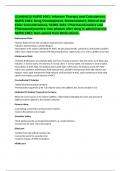(COMBINED) NURS 1061: Infusion Therapy and Calculations,
NURS 1061: Drug Development, Nomenclature, Ethical and
Elder Considerations, NURS 1061: Pharmacokinetics and
Pharmacodynamics: two phases after drug is administered,
NURS 1061: Non-opioid Pain Medications.
Replacement fluids
-Replace fluid lost from the circulatory system(volume expanders)
-Solution: Normal Saline, Lactated Ringer's
-Description: 0.9% sodium chloride(0.9% NaCl), NS plus potassium(K), calcium(Ca), and lactate (a buffer)
-Other uses: replaces NaCl, infused with blood transfusions, replaces Na, Cl, K, and Ca, buffers serum pH
Maintenance fluids
-Maintain fluid balance of cells(fluid shifts out from circulatory system), 100-125 mL/hr, 3L of fluid a day
-Solution: ¼ normal saline, 5% dextrose ¼ normal saline, ½ normal saline, 5% dextrose ½ normal saline
-Description: 0.225% NaCl, 5% dextrose and 0.225% NaCl, 0.45% NaCl, 5% dextrose and 0.45% NaCl
-Other uses: pediatric maintenance fluid replaces NaCl, pediatric maintenance fluid adds calories and
replaces -NaCl, adult maintenance fluid replaces small amounts of NaCl, adult maintenance fluids adds
calories and replaces small amounts of NaCl
Pre-medicated IV Solution
-Added by pharmaceutical company
-Premixed liter bag of D51/2 NS + 20 mEq KCI shows the additive, KCI, clearly marked in red
Medicated IV Solution Prepared by the Nurse
When the nurse inserts an IV solution additive, a label clearly indicating the name and amount of
additive must be applied to the solution container
Primary tubing
-Long tubing connected to primary (main) solution
-Goes to the patient so it is longer
Secondary tubing
-Short tubing used for secondary(intermittent e.g. meds) infusions
-Connects to the port, not to the patient
Distal port
-Farthest from the patient insertion site
-Connection point for secondary line
-Used for infusion of IVPB medications
Middle port
,Connection point to run additional compatible IV solutions
Proximal port
-Closest to insertion site
-Used for administration IV bolus(push) medications
Traditional infusion pump
-Large-volume infusion device capable of delivering volumes as large as 999 mL in 1 hour
-Used for pre-hydration
Syringe pump
-Small-volume infusion device that delivers fluids and medications directly from a syringe; used in
pediatric and critical care settings
-Comes in 5mL, 10mL, 20mL
Patient-controlled analgesia(PCA) pump
Device that allows patient to self-administer IV pain meds with the press of a button
Smart pump
-Computerized infusion pump equipped with medication error-prevention software
-Alarms when infusion settings exceed best practice guidelines
Calculating Electronically Regulated IV Flow Rates (mL/h)
volume/hours= x mL/1 hr
-If the infusion pump is calibrated to the whole number, the IV rate should be rounded to the whole
number
-If infusion pump is calibrated to tenths, the IV rate should be rounded to tenths
-Convert 1 day to 24 hours, convert L to mL
Calculating Manually Regulated Flow Rates (gtt/min) using Formula Method
volume(mL)/time(min) x drop factor(gtt/mL)= x(rate in gtt/min)
V/T x C = R
-Whole drops can be counted only
-Rounded to the whole number, 0.5 gtt is rounded up, 0.4 gtt is rounded down, 38.5 would be 39
-To establish the correct flow rate in gtt/min, count the number of drops for 1 full minute
Calculating Manually Regulated Flow Rates: Time Frame Greater than 1 Hour
-Convert hours to minutes and then use the formula
-V/T x C= R/min
-Infusion rate in mL/h= 100mL/40 min= x mL/60 min
Administration of IV Bolus Medications
, -Calculate volume of medication to administer
-Check drug reference to determine: if medication should be further diluted, length of time over which
to administer medications
-Determine number of 15-second push intervals
-Divide volume of med by number of push intervals
-Administer divided volume every 15 seconds
-4 in 15 seconds for 1 minute, 8 in 2, 12 in 3
-1 mL/4 intervals= 0.25 mL/interval
-Medications go through the proximal port
Time Calculations
-Volume(mL) / rate(mL/h)= time(h)
-Add infusion time to start to determine when infusion will be complete
-1000mL / 100mL/h= 10 hours
Volume Calculations
-Calculate the infusion time by subtraction start time from end time
-Calculate infusion volume: time(h) x rate(mL/h) = volume(mL)
-1000mL @ 85mL/h started at 0630, how much will infuse by 1430? 1000mL / 85= 11.7 hr
Three Checks of IV Therapy
-Check solution
-Check rate
-Check site
Core Ethical Principles
-Respect for persons
-Beneficence: duty to protect pt's from harm/research subjects
-Justice: selection of research subjects be fair
-Autonomy and independence
Phases of Pharmaceutical Research
Preclinical trials: tissue or animal testing
Human clinical experimentation: when approved it's used on humans
-Phase I: small groups
-Phase II: larger groups
-Phase III: larger groups
-Phase IV: after marketing(look to make sure drug doesn't have bad side effects
Clinical research study design
-Independent variable(treatment): new drug
-Dependent variable(outcome): what it's intended to do
Code of ethics




